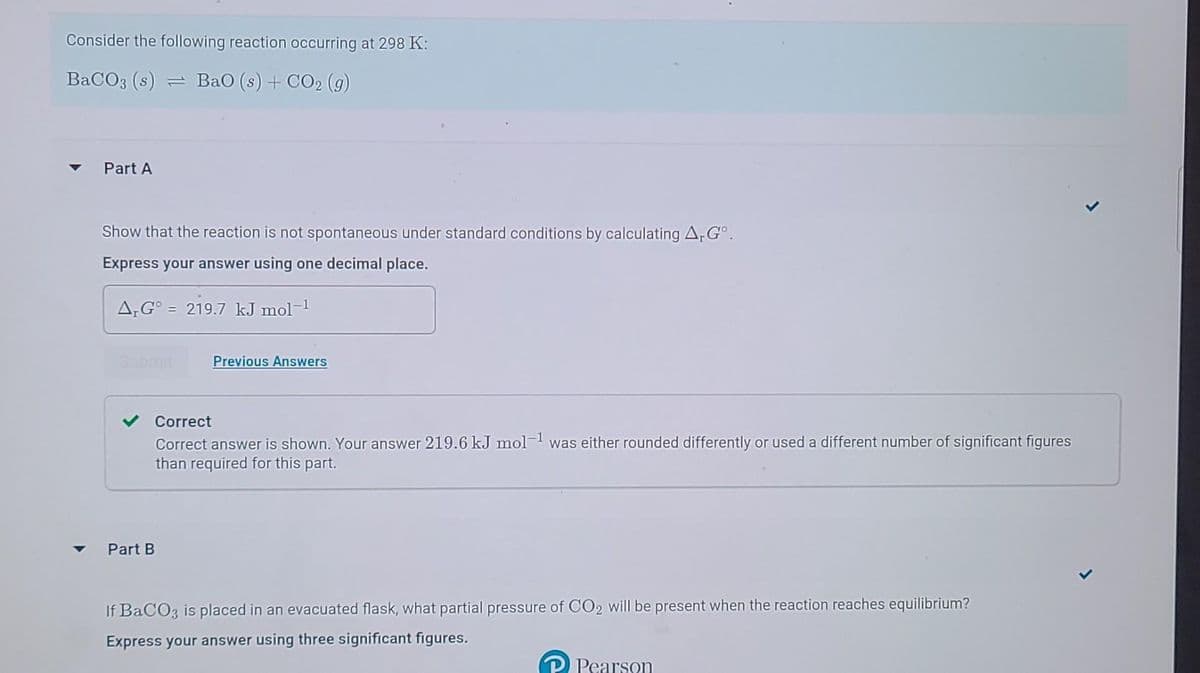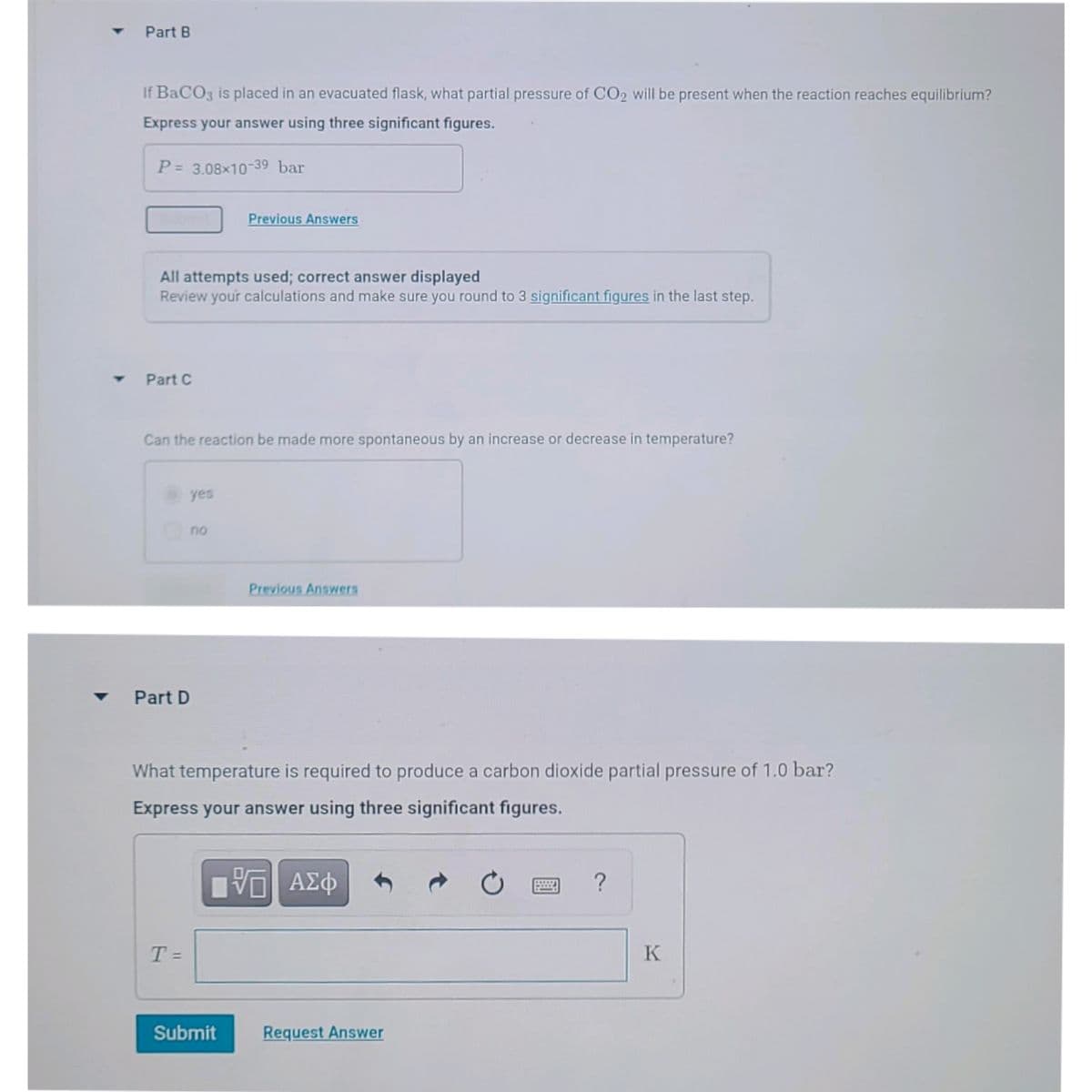Part D What temperature is required to produce a carbon dioxide partial pressure of 1.0 bar? Express your answer using three significant figures. T = Submit Request Answer
Part D What temperature is required to produce a carbon dioxide partial pressure of 1.0 bar? Express your answer using three significant figures. T = Submit Request Answer
Chemistry & Chemical Reactivity
10th Edition
ISBN:9781337399074
Author:John C. Kotz, Paul M. Treichel, John Townsend, David Treichel
Publisher:John C. Kotz, Paul M. Treichel, John Townsend, David Treichel
Chapter18: Principles Of Chemical Reactivity: Entropy And Free Energy
Section: Chapter Questions
Problem 26PS: Is the reaction Si(s) + 2 H2(g) SiH4(g) spontaneous under standard conditions at 298.15 K? Answer...
Related questions
Question
Part D Please !!!

Transcribed Image Text:Consider the following reaction occurring at 298 K:
BaCO3 (s) = BaO (s) + CO2 (g)
Part A
Show that the reaction is not spontaneous under standard conditions by calculating A,G°.
Express your answer using one decimal place.
A,G° = 219.7 kJ mol-1
%3D
Previous Answers
Correct
Correct answer is shown. Your answer 219.6 kJ mol-1 was either rounded differently or used a different number of significant figures
than required for this part.
Part B
If BaCO3 is placed in an evacuated flask, what partial pressure of CO2 will be present when the reaction reaches equilibrium?
Express your answer using three significant figures.
Pearson
>

Transcribed Image Text:Part B
If BaCO3 is placed in an evacuated flask, what partial pressure of CO2 will be present when the reaction reaches equilibrium?
Express your answer using three significant figures.
P= 3.08x10-39 bar
Previous Answers
All attempts used; correct answer displayed
Review your calculations and make sure you round to 3 significant figures in the last step.
Part C
Can the reaction be made more spontaneous by an increase or decrease in temperature?
yes
no
Previous Answers
Part D
What temperature is required to produce a carbon dioxide partial pressure of 1.0 bar?
Express your answer using three significant figures.
ΑΣφ
T =
%3D
Submit
Request Answer
Expert Solution
This question has been solved!
Explore an expertly crafted, step-by-step solution for a thorough understanding of key concepts.
This is a popular solution!
Trending now
This is a popular solution!
Step by step
Solved in 2 steps with 2 images

Knowledge Booster
Learn more about
Need a deep-dive on the concept behind this application? Look no further. Learn more about this topic, chemistry and related others by exploring similar questions and additional content below.Recommended textbooks for you

Chemistry & Chemical Reactivity
Chemistry
ISBN:
9781337399074
Author:
John C. Kotz, Paul M. Treichel, John Townsend, David Treichel
Publisher:
Cengage Learning

Chemistry & Chemical Reactivity
Chemistry
ISBN:
9781133949640
Author:
John C. Kotz, Paul M. Treichel, John Townsend, David Treichel
Publisher:
Cengage Learning

Chemistry: An Atoms First Approach
Chemistry
ISBN:
9781305079243
Author:
Steven S. Zumdahl, Susan A. Zumdahl
Publisher:
Cengage Learning

Chemistry & Chemical Reactivity
Chemistry
ISBN:
9781337399074
Author:
John C. Kotz, Paul M. Treichel, John Townsend, David Treichel
Publisher:
Cengage Learning

Chemistry & Chemical Reactivity
Chemistry
ISBN:
9781133949640
Author:
John C. Kotz, Paul M. Treichel, John Townsend, David Treichel
Publisher:
Cengage Learning

Chemistry: An Atoms First Approach
Chemistry
ISBN:
9781305079243
Author:
Steven S. Zumdahl, Susan A. Zumdahl
Publisher:
Cengage Learning

Chemistry
Chemistry
ISBN:
9781305957404
Author:
Steven S. Zumdahl, Susan A. Zumdahl, Donald J. DeCoste
Publisher:
Cengage Learning


Chemistry: Principles and Practice
Chemistry
ISBN:
9780534420123
Author:
Daniel L. Reger, Scott R. Goode, David W. Ball, Edward Mercer
Publisher:
Cengage Learning